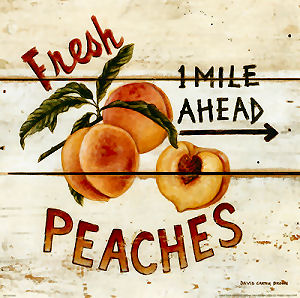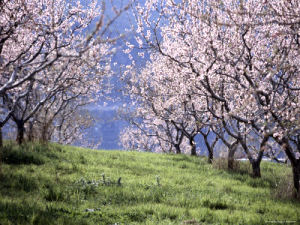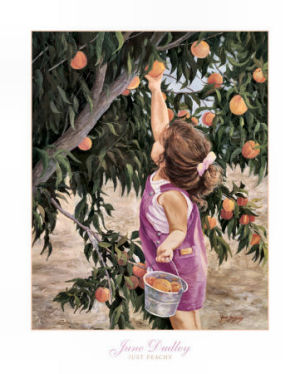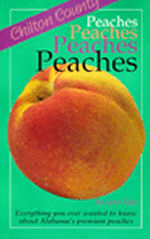
HOME
INTRO
SYMBOLS
ALMANAC
ECONOMY
GEOGRAPHY
STATE MAPS
PEOPLE
FORUM
NEWS
COOL SCHOOLS
STATE QUIZ
STATE LINKS
BOOK STORE
MARKETPLACE
GUESTBOOK
CONTACT US


Alabama State Tree Fruit
Adoption of the Alabama State Tree Fruit

Alabama State Tree Fruit: Peach
Peachy photographs and prints
On January 10, 2006, House Bill No. 205 (HB205) was read for the first time in the House of Representatives. Having adopted the blackberry as Alabama's official state "fruit" in 2004, Alabama Representative James M. Martin, representing Chilton County, sponsored HB205 proposing that the peach be designated the official "tree fruit" of the state.
On February 21, HB205 was adopted by the House of Representatives, with only one nay vote, and forwarded to the State Senate for their consideration.
On March 2, 2006, House Joint Resolution No. 321 (HJR321), also sponsored by Representative Martin and approved by the Alabama House of Representatives and the Senate, was forwarded to Governor Bob Riley for his signature.
HJR321 commended Chilton County farmers for the donation of "large, beautiful baskets of peaches for the Southern Legislative Conference in Mobile, Alabama" as well as the "especially delightful and tasty flavor" of the peaches.

Alabama State Tree Fruit: Peach
Peachy photographs and prints
Interested parties in the Peach State took notice of the legislation approved by the Alabama House of Representatives. Georgia, the country's third largest producer of peaches with a protective hold on all things "peach," reacted.
Robert Dickey of Musella, Georgia, past president of the Georgia Peach Council and a fourth-generation peach grower, responded in the New York Times 1, "Georgia is the Peach State. We're known internationally as the Peach State. We have always been the Peach State, and we think we have the best peaches in the world."
"We probably grow 10 times as many peaches as they do," Mr. Dickey said
HB205 sponsor, Representative James Martin had this to say about Alabama peaches. "If you've ever tasted Alabama peaches, you'd throw rocks at Georgia."
Thomas Irvin, Georgia's agricultural commissioner, responded, "I didn't realize Alabama had any peaches at all."
At about this time, the South Carolina Peach Council weighed in. On March 15, they issued a press release, "South Carolina Welcomes Alabama to the Peach Bandwagon."
FOR IMMEDIATE RELEASE
March 15, 2006South Carolina Welcomes Alabama to the Peach Bandwagon
COLUMBIA, SC - The South Carolina Peach Council, a membership organization representing peach industry of South Carolina, welcomes Alabama to the peachy keen bandwagon.
Alabama has recently selected the peach as their official state "tree fruit," and that is just fine as frog hair with the South Carolina Peach Council.
"Alabama's choice just goes to show the popularity of the peach," said Julie Huffman, Executive Director of the SCPC. "The more voices supporting the fruit the better."
After California, South Carolina is the second largest producer of peaches in America. The peach is South Carolina's state fruit and, as an industry, peaches bring in approximately $40 million and pay out to other industries, such as freight and labor, over $50 million.
South Carolina welcomes Alabama to the peach community and invites consumers to "Taste the Difference" of Palmetto State peaches.
The South Carolina Peach Council is an association of local growers, packers, and retailers who are dedicated to advance and protect the production and marketing of peaches in South Carolina. Using a network of valued relationships, the SCPC seeks to educate families across the nation about why South Carolina is "The Tastier Peach State." The Palmetto State's slightly acidic soils, hot days, and humid nights enable our growers to offer consumers peaches ripened by Mother Nature and packed with nutrients and flavor.
Through joint collaboration between the SCPC and local retailers, fundraising efforts support research and promotion initiatives for South Carolina peaches. Research efforts through major southeastern universities keep producers on the cutting edge of production technology to bring consumers the highest quality best tasting peach in the marketplace. Investments in these technologies ensure that consumers will benefit from increased quality and food safety standards. Promotional efforts invite consumers to taste the difference for themselves and to enjoy our higher quality fruit all summer long. The SCPC realizes consumers have a choice and we thank you for choosing South Carolina peaches.
For more information about the SC Peach Council or South Carolina's "tastier peaches", contact Julie Huffman, South Carolina Peach Council, at cell: 803-528-6009, office: 803-734-2151, fax: 803-724-0325 or jhuffman@scda.sc.gov.
Meanwhile, HB205, naming the peach the official tree fruit of Alabama, was read in the Senate for a second time and scheduled for a third reading and vote.

Peach Pickin' Time in Alabama
Peachy photographs and prints
On April 17, HB205 was approved unanimously by the full Alabama Senate and forwarded to Governor Bill Riley for his signature
Riley responded to Georgia, "We don't want to have an argument. We just think our peaches taste better," and said that Georgia Governor Sonny Perdue was "more than welcome" to attend the signing to take place in a Chilton County peach orchard.
Governor Bob Riley signed HB205 into law on April 18, 2006, making the peach the official State tree fruit of Alabama
The peach is also the official fruit of
- South Carolina (1984) and
- Georgia (1995)
Peach Production Facts:
California produces more peaches than all other states combined. South Carolina follows at distant second, followed by Georgia, followed by New Jersey.
Alabama Law
The following information was excerpted from the Alabama Revised Statutes, Title 2, Chapter 10.
TITLE 1.
ARTICLE
Chapter 2 STATE SYMBOLS AND HONORS.
Section 1-2-37 State tree fruit.
Section 1-2-37
State tree fruit.
The Peach, Rosaceae, genus Prunus, species P. persica, is hereby designated as the official state tree fruit of Alabama.
(Act 2006-520, §1.)
Sources...
The Code of Alabama 1975. Alabama State Legislature. 2008. 30 September 2008
State Tree Fruit of Alabama. Alabama Department of History & Archives. 2008. 30 September 2008
Governor signs bill making peach Alabama's official state tree fruit. The Columbus Ledger-Enquirer. 2008. 21 April 2006
South Carolina Welcomes Alabama to the Peach Bandwagon : South Carolina Department of Agriculture. 2008. 15 March 2006
1 Alabama Adopts the Peach, Nettling Growers Next Door. The New York Times. 2008. 24 February 2006
Additional Information
State Tree Fruit of Alabama: Alabama Department of Archives & History: Official Symbols and Emblems of Alabama.
Prunus persica (L.) Batsch: Peach: USDA, NRCS. 2004. The PLANTS Database, Version 3.5 (http://plants.usda.gov). National Plant Data Center, Baton Rouge, LA 70874-4490 USA.
 :
United States Department of Agriculture: Forest Service. Fact Sheet ST-513, October 1994..
:
United States Department of Agriculture: Forest Service. Fact Sheet ST-513, October 1994..
Peach Rosaceae Prunus persica (L.) Batsch var. persica: Virginia Tech, Department of Forestry: College of Natural Resources Fact Sheet..
Prunus persica Peach: Bioimages from the Department of Biological Sciences of Vanderbilt University.
State Fruit: Complete list of official state fruit.
More symbols & emblems: Complete list of official Alabama state symbols.

Chilton County Peaches
by Lynn Edge & Clint Wilkes
Chilton County Peaches: Everything You Ever Wanted to Know about Alabama's Premium Peaches, by Lynn Edge and Clint Wilkes. 84 pages. Seacoast Publishing (December 1994)
How to Pick a Peach: The Search for Flavor from Farm to Table, by Russ Parsons. 432 pages. Mariner Books; Reprint edition (May 1, 2008) "Eat locally, eat seasonally." A simple slogan that is backed up by science and by taste. The farther away from the market something is grown, the longer it must spend getting to us, and what eventually arrives will be less than satisfying. Although we can enjoy a bounty of produce year-round -- apples in June, tomatoes in December, peaches in January -- most of it is lacking in flavor. In order to select wisely, we need to know more. Where and how was the head of lettuce grown? When was it picked and how was it stored? How do you tell if a melon is really ripe? Which corn is sweeter, white or yellow?
Month-by-month Gardening In Alabama, by Bob Polomski. 368 pages. Cool Springs Press (April 11, 2002) Month-by-Month Gardening in Alabama is written by the highly regarded gardening expert Felder Rushing. Contains monthly advice on what to do and when to do it in the garden. The book contains 12 plant categories ranging from annuals to vines.
Peaches and Other Juicy Fruits: From Sweet to Savory, 150 Recipes for Peaches, Plums, Nectarines and Apricots , by Olwen Woodier. 192 pages. Storey Publishing, LLC (June 1, 2004) Peaches. Plums. Nectarines. Apricots. They're summer's sweethearts. Eating them fresh off the tree, still warm from the sun, is one of the high points of the year. Award-winning cookbook author Olwen Woodier offers stone fruit lovers 150 enticing ways to savor these sweet and tangy flavors of summer.
The Great Southern Food Festival Cookbook: Celebrating Everything from Peaches to Peanuts, Onions to Okra, by Mindy Henderson. 320 pages. Thomas Nelson (November 4, 2008) A food festival is a wonderfully American event that happens in small towns and large cities all over the South, celebrating everything from onions to peanuts, chocolate to chowder. This collection will be both cookbook and travel guide with delicious recipes and festival information for more than 70 festivals from Virginia to Texas. Southern food and Southern parties-or rather Southern parties about Southern food-are the very best kind.
Peach Cookbook: Beverages, Breakfast Treats, Appetizers, Soups, Salads, Entrees, Desserts, by Mimi Brodeur. 128 pages. Stackpole Books; Spi edition (March 30, 2009) Sweet and succulent, peaches are America's favorite fruit. In Mimi's newest book of original recipes, peaches maintain their starring role in desserts, such as sumptuous peach ice cream, peach schnappy creme brule, and peach upside-down cake with rum cream. But the fruit adds new character depth to other dishes--buttermilk peach muffins or blackberry peach French toast for breakfast, peach bruschetta or chilled peach soup for an appetizer, and smoke-rubbed skirt steak with peach chive butter or spicy pork spareribs with peach glaze for a main course at dinner. A variety of recipes for beverages--from sparkling peach lemonade to peach crantini--are included as refreshing accompaniments.
The Organic Gardener's Handbook of Natural Insect and Disease Control: A Complete Problem-Solving Guide to Keeping Your Garden and Yard Healthy Without Chemicals, edited by Barbara W. Ellis and Fern Marshall Bradley. 544 pages. Rodale Books; Revised edition (May 15, 1996) An excellent handbook with entries for common fruits, flowering plants, vegetables, and trees. Each listing has information on disease and pest problems and tips on how to solve them without chemicals. Especially useful sections feature photos of garden insects and diseases.
The Omnivore's Dilemma: A Natural History of Four Meals, by Michael Pollan. 464 pages. Penguin Press HC, The (April 11, 2006) The bestselling author of The Botany of Desire explores the ecology of eating to unveil why we consume what we consume in the twenty-first century
In Defense of Food: An Eater's Manifesto, by Michael Pollan. 256 pages. Penguin Press HC, The (2008) In looking toward traditional diets the world over, as well as the foods our families-and regions-historically enjoyed, we can recover a more balanced, reasonable, and pleasurable approach to food. Michael Pollan's bracing and eloquent manifesto shows us how we might start making thoughtful food choices that will enrich our lives and enlarge our sense of what it means to be healthy.
Garden tools from Amazon.com!
 Custom Search
Custom Search

